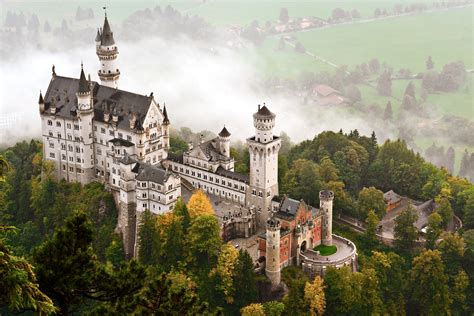Neuschwanstein Castle in Germany stands as a breathtaking example of romantic architecture and fairy-tale grandeur. Nestled in the Bavarian Alps, this iconic castle was commissioned by King Ludwig II of Bavaria in the 19th century and has become one of the most visited landmarks in Europe. Its picturesque setting and intricate design have captivated visitors and inspired countless stories and films. Exploring Neuschwanstein Castle reveals the vision of a monarch with a profound appreciation for art and fantasy, offering a glimpse into a world of medieval fantasy and architectural innovation.
The History of Neuschwanstein Castle
Neuschwanstein Castle was commissioned by King Ludwig II of Bavaria in 1869, with the intention of creating a private retreat that embodied his romantic ideals. The construction was influenced by Ludwig’s admiration for medieval knights and legends, and he envisioned the castle as a tribute to the operas of Richard Wagner. The project, however, remained incomplete at the time of Ludwig’s mysterious death in 1886. Despite its unfinished state, Neuschwanstein Castle remains an architectural marvel, showcasing Ludwig’s vision and the historical context of late 19th-century Europe.

Architectural Design and Features
The architectural design of Neuschwanstein Castle reflects a blend of various styles, including Romanesque Revival, Gothic Revival, and Byzantine influences. The castle’s exterior is adorned with turrets, towers, and intricate carvings, while the interior boasts lavish rooms decorated with themes from Wagnerian opera. Notable features include the lavish Throne Room, with its Byzantine-inspired mosaics, and the opulent Singers’ Hall, showcasing Ludwig’s passion for music and theater. The castle’s design combines historical elements with imaginative details, creating a unique and enchanting structure.
The Scenic Location and Views
Neuschwanstein Castle is perched on a rugged hilltop overlooking the picturesque landscape of the Bavarian Alps. The castle’s location provides stunning views of the surrounding countryside, including the nearby Hohenschwangau Castle and the turquoise waters of the Alpsee Lake. The dramatic backdrop of the Alps, combined with the castle’s fairy-tale architecture, creates a visually captivating scene that has made Neuschwanstein one of the most photographed and iconic landmarks in the world. Visitors often marvel at the seamless integration of the castle with its natural surroundings.
The Influence of Richard Wagner
Richard Wagner, the famous composer, played a significant role in inspiring the design and conception of Neuschwanstein Castle. King Ludwig II was a devoted patron of Wagner and sought to create a castle that reflected the themes and grandeur of Wagner’s operas. The castle’s interiors, including the elaborate murals and decorative motifs, are heavily influenced by Wagner’s works, particularly his operas based on medieval legends and myths. This connection to Wagner adds a layer of artistic and cultural significance to the castle, linking it to the broader context of 19th-century European art and music.
Tourism and Popularity
Neuschwanstein Castle is one of the most popular tourist destinations in Europe, attracting millions of visitors each year. Its fairy-tale appearance and historical significance make it a must-see attraction for travelers from around the world. The castle’s popularity has led to a range of tourism-related activities, including guided tours, exhibitions, and cultural events. Despite the high volume of visitors, efforts are made to preserve the castle’s integrity and ensure that the experience remains enjoyable and informative for guests.
Vote
Who is your all-time favorite president?
Preservation and Restoration Efforts
Maintaining and preserving Neuschwanstein Castle is a critical aspect of ensuring its longevity and continued appeal. Ongoing restoration efforts focus on addressing the wear and tear caused by weather, tourism, and aging materials. The castle’s management employs conservation experts to oversee repairs and maintain the historical accuracy of the structure. These efforts are essential for preserving the castle’s architectural and cultural heritage, allowing future generations to experience its beauty and historical significance.
Cultural and Historical Significance
Neuschwanstein Castle holds immense cultural and historical significance beyond its architectural splendor. It embodies the romantic ideals of 19th-century Europe and reflects the personal vision of King Ludwig II. The castle has become a symbol of fantasy and escapism, influencing popular culture and inspiring countless stories and films. Its association with Wagner’s operas further enriches its cultural value, linking it to the broader narrative of European art and history. Understanding the castle’s significance provides a deeper appreciation of its role in shaping cultural and historical narratives.
Events and Celebrations
Neuschwanstein Castle hosts various events and celebrations throughout the year, adding to its allure as a cultural and historical destination. Seasonal events, such as Christmas markets and medieval-themed festivals, provide visitors with unique experiences that enhance their understanding of the castle’s history and significance. Special exhibitions and performances related to Wagner’s operas are also held, offering additional insights into the castle’s artistic connections. These events contribute to the dynamic experience of visiting Neuschwanstein, providing opportunities for guests to engage with its rich history and cultural heritage.
Advertisement
Future Developments and Challenges
As one of the most visited landmarks in Europe, Neuschwanstein Castle faces ongoing challenges related to tourism management, conservation, and modernization. Balancing the needs of visitors with the preservation of the castle’s historical integrity requires careful planning and innovative solutions. Future developments may focus on enhancing visitor experiences while ensuring the long-term preservation of the castle. Addressing these challenges involves collaboration between conservation experts, tourism officials, and local communities to safeguard Neuschwanstein’s legacy for future generations.
Summary
Neuschwanstein Castle in Germany stands as a testament to romantic architecture and historical imagination. Its stunning design, scenic location, and connection to Richard Wagner make it a symbol of fairy-tale fantasy and cultural heritage. The castle’s popularity, combined with ongoing preservation efforts and cultural significance, ensures that it remains a beloved and enduring landmark. Exploring Neuschwanstein Castle offers a glimpse into the vision of King Ludwig II and the broader historical and artistic context of 19th-century Europe, making it a truly captivating destination.